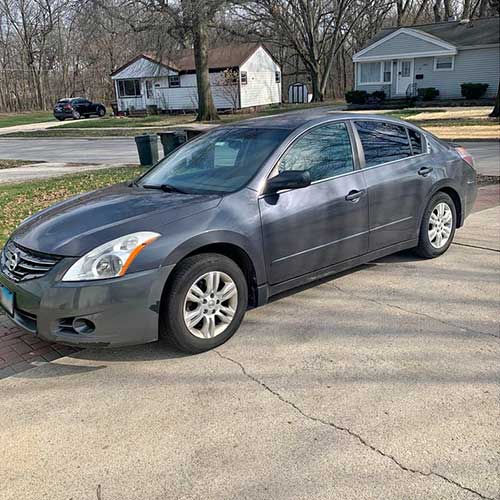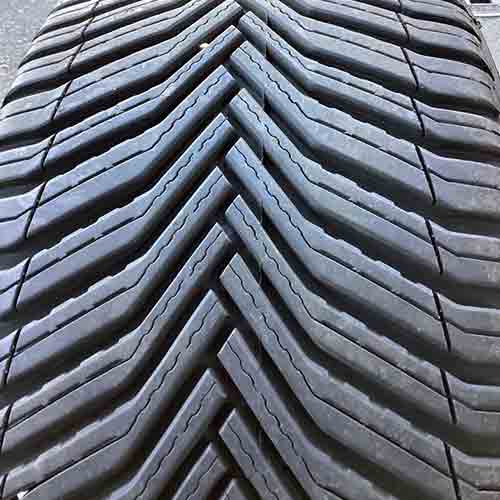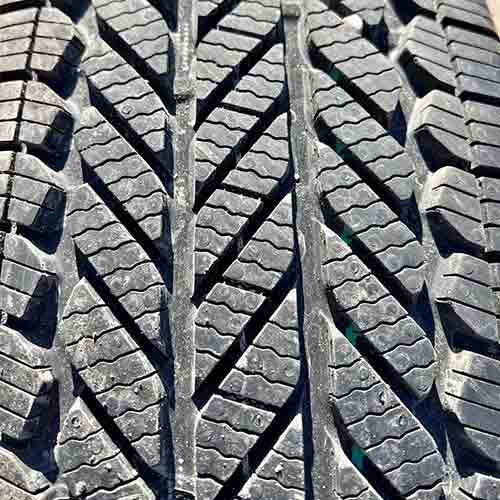Both the Michelin Crossclimate 2 and the Bridgestone WeatherPeak are grand touring all weather tires which bring a lot to the table, providing decent traction and comfort in multiple environments. But there are definitely some significant difference to note between the two. Let me share them with you.

Table of Contents
Key-points to Note
Michelin CrossClimate 2 excels in:
- Hydroplaning Resistance: Offers efficient water evacuation with its V-shaped tread.
- Dry Grip: Provides enhanced directional control and faster braking due to its densely packed central lugs.
- Winter Performance: Superior in snow traction with elongated lugs and interlocking sipes.
Detailed Discussion on Michelin’s tire: https://tiredriver.com/michelin-crossclimate-2-review/
Bridgestone WeatherPeak leads in:
- Wet Handling: Superior due to full-depth interlocking sipes.
- Fuel Efficiency: Lower rolling resistance thanks to its lighter structure.
- Noise Reduction: Utilizes Whisper Grooves and Variable Pitch technology for quieter operation.
- Durability: Slower tread wear and increased longevity due to harder compound and lower rolling resistance.
Detailed Discussion on Bridgestone’s tire: https://tiredriver.com/bridgestone-weatherpeak-review/
Useful Info on Sizes
| Specs | Cross Climate 2 | Weather Peak |
|---|---|---|
| Rim Sizes | 16 to 22 inches | 15 to 20 inches |
| Speed Ratings | H and V | T, H, and V |
| Load Ratings | SL and XL | SL and XL |
| UTQG | 640 B A | 700 A A |
| Tread Depth | 10.5/32″ (on all) | 10/32″ (on all) |
| Weight Range | 25 to 36.5 lbs | 17 to 30 lbs |
| Winter Ratings | Yes, 3PMSF on all sizes | Same, 3PMSF and M+S |
| Wear Warranty | 60k miles | 70k miles |
For Your Info: Have you considered other top grand touring tire’s I’ve personally reviewed? Well, you should: https://tiredriver.com/best-grand-touring-all-season-tires/
Structure Differences
Let’s start things off here with Michelin CrossClimate 2.

So this tire shows up with an innovative and unique, directional tread pattern characterized by V-shaped lugs, which are gracefully elongated, I should say.
These lugs function like traction spoons for the tire, displacing water, slush, and snow, thanks to their expansive, curving arms, allowing for epic winter traction, as you’d see in the upcoming topics.
If you consider the image, you’d see that the lugs are neatly divided by longitudinal slits, these basically separates the shoulder area form the central blocks.
The shoulder lugs have larger tread voids, and carry rectilinear sipes.
While towards middle, these lugs get closed up together, have snow vices on the edges, and are equipped with interlocking wave-like siping.
Overall, I must say, its a very genius design, as with closed up lugs, the tire offer dry traction, snow vices give winter performance, while the interlocking sipes help in wet conditions.
On the other hand, the Bridgestone WeatherPeak is also pretty unique.

It distinguishes itself with an advanced, symmetrical tread pattern where you see very squared off lugs, strategically placed to provide excellent traction and control.
They form 3 ribs in the middle, which together render 4 very tough passing circumferential grooves.
In this densely arranged central region, the lugs are fortified with zigzag siping, and chamfered edges, which basically enhance grip and stability in all conditions including snow and ice, allowing the tire to have 3 peak mountain snowflake rating, just like its counterpart.
Moving towards shoulders, you see relatively bigger lugs here, with smoother edges, and rectilinear sipes. These lugs also seem to be divided up by thick longitudinal slits as well.
A side note: Before diving deep in to the comparison, I think its best you check this video out. I am working with these guys.
Wet Traction
Wet performance is primarily influenced by two elements: hydroplaning resistance and wet grip. Let’s take a look at them both one by one.
Wet Grip
Simply put, wet grip highly depends on sipes.
Though, regrettably, the Michelin CrossClimate 2 is somewhat lacking in this aspect, due to its relatively fewer sipes, particularly towards the tire’s shoulders. This limitation impacts its overall handling proficiency in wet.
To explain the working, sipes are small slits embedded in the tread that function as water vacuums, soaking up particles, so that tread can easily contact the surface. So their flexibility also matters.
The CrossClimate 2 although features good enough wet grip, shown by braking distances, it’s handling times lack to most of the premium all season tires, like the WeatherPeak.
This is because, besides having lesser siping, it’s shoulders are also equipped with rectilinear ones, which often get stiffer on sharper turns (as such sipes don’t allow flexibility).
Here, the Bridgestone WeatherPeak stands out, as its full-depth interlocking sipes offering superior handling performance in all sorts of wet conditions.
Hydroplaning
While the Michelin CrossClimate 2 may not be a front-runner in wet handling, it notably shines in hydroplaning resistance.
And its commendable performance can be attributed to its unique V-shaped tread design, which provide very efficient pathways for the water particles coming at front (as the tire rolls), to easily move out through streamlined tread voids.
On the other side, the WeatherPeak faces certain obstacles here, due to it’s continuous longitudinal ribs.
These ribs basically are very closely aligned for one, and don’t allow as efficient of the water removal, especially sideways.
And this explains why the tire Bridgestone features better float speeds on straight aqua tests, compared to curved.
Fuel Consumption
Fuel consumption is greatly affected by rolling resistance, a factor heavily dependent on a tire’s internal and external construction.
Having said that, the Bridgestone WeatherPeak takes the lead here with its lighter overall structure. With this the lugs have smaller weight pressure on them, as they rub off the surface, and so you get lower rolling resistance values.
Moreover, the Michelin CrossClimate 2 showcases a slightly aggressive tread pattern, with more voids particularly towards shoulders.
And with it’s heavier overall structure, it’s weight distributing on a relatively smaller rubber area creates a lot more friction levels, relatively.
And of course, it’s softer compound isn’t helping to that either.
So you would slight drop in mpg, switching from WeatherPeak to Michelin’s tire.
A Side Note Here: If fuel economy is something that matter more to you (than other performance aspects), then maybe you should consider a standard touring tire instead. Find them on my main all-season tire page.
Tread Noise
Noise in tires is largely generated when air collides with the tread, primarily entering through the shoulders.
And Bridgestone WeatherPeak addresses this issue with its Whisper Grooves technology, (a term borrowed from Cooper Tires, I must add).
This tech basically involves in placement of ridges/connectors between the shoulder blocks. I other words, shoulder voids are somewhat blocked in order to entry of air particles.
Though despite these barriers, a small amount of air can still infiltrate, and that is dealt with Variable Pitch technology on this tire.
Now this tech accounts for altering the geometry of the lugs slightly, in order to create varying pitches when air particles strike around (the lugs on different areas). And those tones with varying frequencies don’t allow sound-waves to amplify.
On the other side, the Michelin CrossClimate 2 lacks, but only marginally, I mean you’d won’t notice much (comparing both tires), in real life scenario.
So why is that?
Well the tire although features wider shoulder voids that allow air entry, it still mitigates noise with it’s swooping lugs, which are actually very streamlined.
That means that air doesn’t directly collide with the tread walls, and instead, it flows smoothly in and out of the tire without striking the surrounding walls.
For Your Info: According to my tests, the Pirelli Cinturato SF2 (review) is the quietest “grand touring” tire (out of all I’ve reviewed so far, and I think I’ve covered them all).
Dry Traction
Dry traction can be explained by looking into grip and handling, with grip typically calculated through braking distances and handling assessed by evaluating lap times. And consider both I must say, both tires offer impressive performance in these aspects.
However, the CrossClimate 2 still get an upper hand here, especially in the grip department. This is largely due to its densely packed central lugs and a rounded contact patch, which allow for a firmer road grip leading to enhanced directional control and expedited braking performance.
On the other side, the the Bridgestone WeatherPeak shines in the handling department, providing outstanding stability and responsive steering, thanks to its lighter weight and interconnected shoulder blocks that afford a larger contact patch.
This is unlike the Michelin’s tire, which sports larger tread voids on the outer shoulder.
Durability and Tread Wear
Michelin’s tire exhibits a slightly elevated rolling resistance, which directly correlates to faster tread wear.
Its heavier weight results in each lug bearing more pressure, thereby increasing friction with the road surface and leading to quicker rubber wear.
Furthermore, its softer tread compound doesn’t aid its cause either, as the rubber is more prone to faster degradation.
Nonetheless, it’s crucial to note that the CrossClimate 2’s increased weight is a result of its robust internal construction, implying that it generally offers superior durability when compared to its counterpart.
Its sturdy design, inclusive of wide steel belts, a seamless full-cover reinforcement ply, and folded belt-edge tape, confers enhanced reliability and a better defense against punctures.
But yes, overall, this ones a win for Bridgestone.
Winter Performance
Winter traction is the area where CrossClimate 2 is the true champ, where the tire strikes an impressive balance, manifesting superior capabilities across all the requisite performance metrics.
I mean, its elongated lugs with snow vices and central interlocking sipes, effectively scoop up slush and snow as the tire rolls, creating enhanced forward momentum when compared to other competitors including the WeatherPeak (even though both tires are 3 Peak Mountain Snowflake (3PMSF) rated).
For those not familiar, the 3PMSF rating primarily denotes an acceleration test. And its just a common misconception that it pertains to braking and handling on snow. It simply tells that a tire (with this rating) performs approximately 10% better than an average all-season tire, when it comes to snowy road acceleration.
Furthermore, CrossClimate 2 has narrower section width, and heavier weight (considering all its sizes). Both of these allow the tire to put more pressure on the snow, as they get effectively lodged in the tread, and then form optimal snow-to-snow contact.
This is important as snow sticks better with each other, instead of rubber.
So overall, although both tires are great here, the Michelin still takes the lead.
To Sum Up
In conclusion, choosing between the two tires can be a complex task, given that each demonstrates unique strengths in specific areas.
I mean, when it comes to winter traction, the CrossClimate 2 undoubtedly comes out on top. Its unique design, featuring elongated lugs and thermally adaptive rubber, ensures optimal snow-to-snow contact.
Though Weatherpeak is also great, and has 3 peak mountain snowflake rating just like it’s counterpart.
Dry traction is another category where the Michelin’s tire slightly outperforms, thanks to its densely packed central lugs and a rounded contact patch.
Though in terms of handling Bridgestone’s tire also demonstrates impressive performance. It actually has better under and over steering balance thanks to its weight.
Speaking of which, its lighter construction also contributes to its longer tread life, and fuel economy. And the tire also excels when it comes to noise reduction, and overall wet traction.
Side Note: Did my comparison help you make a decision? I’d love your feedback.
Great comparison and technical breakdown. Michelin tires are consistently very good. But pricing is high.
Thank you, Jerry! I agree, Michelin tires are consistently of high quality, although they do tend to be on the pricier side. It’s important to weigh the cost against the benefits and consider the long-term value. I’m glad you found the comparison and technical breakdown helpful!
Appreciate the detailed evaluation and comparison. The UTQG Treadwell rating does not reflect comparative mileage between 2 competitive brands only within a brand as this is not a government requirement.
As a Value with very similar performance to bother the Michelin and Bridgestone, recommend the Kenda Vezda Touring 4S which is also 3PMSF certified with tremendous wet and dry handling for a ~30% lower price.
Yes, you’re right my friend. I actually have a detailed read on UTQG, check it out here, it will give you all the info you need.
Fantastic review.
Thank you very much.
Thank you for the positive feedback, Hugh! I’m delighted to hear that you found the review helpful. It’s always great to hear from satisfied readers!
Thank you for the review. My garage told me that unfortunately Michelin do not make the Crossclimate 2 for my size and suggested the Weatherpeak one as a very good alternative. Your review confirms this advice.
I’m glad you found the review helpful! It’s unfortunate that the Michelin Crossclimate 2 isn’t available for your size. However, the Weatherpeak is indeed a decent alternative.
I really appreciate the thoroughness of your reviews and comparisons!!
Hello Ozmen,
Thanks for the great article!! I just put CrossClimate 2’s on my car in preparation for Winter in Northern Utah (traction will be vital for making it up the canyons as a rideshare driver). I immediately noticed a significant drop (3-4 mpg) in fuel economy and increased the air pressure in the tires (recommended by my car dealership and some online forums) in an attempt to counteract the high rolling resistance and improve gas mileage. My concern about gas mileage is based on my plan to use the tires year round. My vehicle recommends 35 psi and I’m currently between 40-42 (max psi is 51). Is this an effective strategy? If so, can it be done year round?
Additionally, it sounds like the Weatherpeak’s have slightly lower rolling resistance but I’m wondering if the difference in fuel economy between the two tires would be significant enough to warrant changing to the Bridgestones. (Costco will allow me to return the Michelins for up to a month).
There is definitely a difference, where Crosscliamte 2 showcases lower fuel economy. So if that’s really the issue, I think it’s better to go for WeatherPeak. Also if you plan on using Crossclimate, make sure you get the one with lowest speed rating and lighter of all weight, (of course from the choices you’d have for your car). I mean that’s better than playing around with pressure.
Also, you may want to check out my air pressure guide, and posts on fuel and tread, (search them out in the “search bar”).
Thanks for your input!! I’ll check out the guide and posts that you mentioned
Great review. Its very technical and help explain the tires from specification (thread design) perspective.
One point that could be useful for end user is to compare the ride quality (comfortability). I have both tires and I feel CC2 drive sportier (you feel the vibration more, feel the impact of road, etc), and WeatherPeak drive more comfortable (more cushion). Its like driving Mercedes vs BMW. One possibility that I can think of maybe it’s due to sidewall stiffness? Thought?
Yes, well TBH when it comes to these two tires, their comfort really vary from size to size… So its a bit complicated. But really appreciate you comment Wilson.